#dwarf fireweed
Text
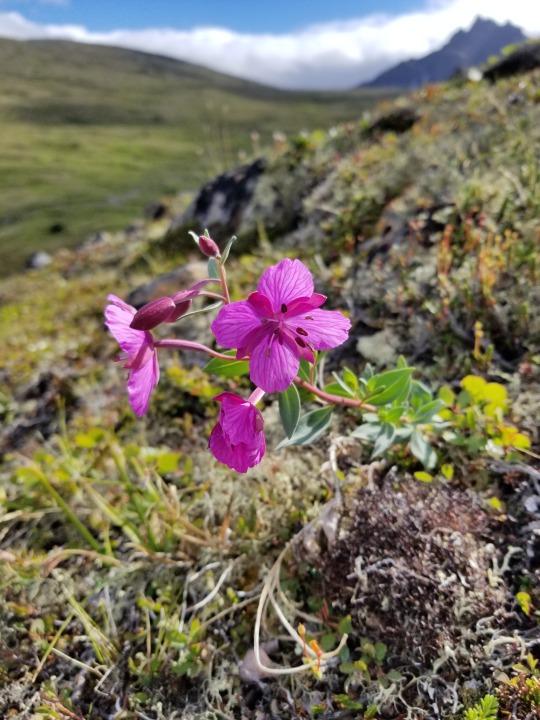
Chamaenerion latifolium, formerly in the genus Epilobium, is commonly known by both as beauty willowherb, broadleaf fireweed, and dwarf fireweed. This species is circumboreal, found in Eurasia and North America, primarily in the Arctic and subarctic. We found this individual on the alpine tundra in the Chugach Mountains near Anchorage, Alaska, but it's probably best known in Greenland, where it's the national flower! In Greenlandic (kalaallisut), it's known as niviarsiaq, which translates to "young girl".
In the Anchorage area, it used to be common among the Dena'ina to harvest dwarf fireweed when it was young and eat it along with meat, either cooked or raw. However, the more commonly harvested species is the ubiquitous Chamaenerion angustifolium, which most people in North America know simply as fireweed.
#chamaenerion latifolium#beauty willowherb#breadleaf fireweed#dwarf fireweed#niviarsiaq#botany#plants of alaska
56 notes
·
View notes
Photo
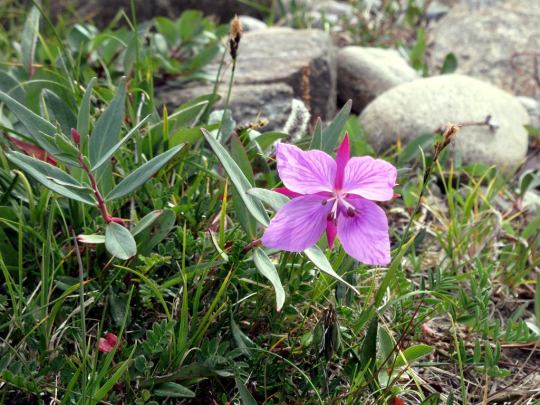
Pink dwarf fireweed flourishes along the banks of the Sylvia Grinnell River near Iqaluit, Nunavut, Canada.
3 notes
·
View notes
Text
Planted my new arrivals, staked my sunflowers, asters, and white sage so they stop growing into the sidewalk or over top of other plants that would also like to have sun in that area, thank you very much! Also among my arrivals is yet another sunflower species, but you don’t understand! I needed it! It’s Helianthus annuus! The one with the seeds, and it’s not a cultivar, it’s just the regular form! *ahem* Anyway, the rocky mountains bee plant, white sage, fringed aster, and northeastern black cherry tomato should give it a run for its money in that area. And it’s an annual, so each plant in the spring is new, it doesn’t spread by rhizome like the perennial sunflowers do.
Watered my whole garden, which I can do now because I have use of my hose, and inundated my wet plant areas, which allows them to not just survive but thrive. There’s a robin that comes around now to grab the worms that come up when I do this. Earth worms are not good for native North American plants, so it’s a symbiotic relationship, and I’m pretty sure the robin thinks I’m intentionally making the worms come up for her. She keeps looking at me expectantly every day. lol
After losing the only two arctic raspberries that popped up in the spring, I am trying new plants in a different area. Fingers crossed or else I will find it’s just not meant to be. Also got replacement dwarf fireweeds after some animal or other dug the other up and killed them. Sometimes you just have to keep trying. Like with my wood lilies. First two attempts failed before the third finally stuck. In fact this year I’m on my third attempt with (regular) fireweed, tufted hair grass, early blue violet, and upright prairie coneflower, and on my second attempt with several others. My roundheaded bushclover is doing fine in its second year after two failed attempts to grow it in previous years. So I’ll have hope that this year’s the year for them. Sadly my mountain blue-eyed grass did not thrive and eventually died. Haven’t been able to find a replacement yet, but I have a different area in mind for when I do and hopefully that will be the place for it.
I collected some beans from my rocky mountains bee plants and some pods from my swamp milkweed. Then I got tired (because it’s been very warm today) and just chilled on the grass watching the insect activity on my flowers. Tomorrow I’m going to gather some greens from my garden and go to the ravines for some more milkweed pods. I will then cook them with the shrimp I found in my freezer.
8 notes
·
View notes
Photo

dwarf fireweed :-) (Aug 2022)
2 notes
·
View notes
Photo

Wildflowers of Eastern Greenland Greenland may not be green, but it the short summer period it explodes with wildflowers. Many bloom for a very short time - weeks or perhaps even days, almost all are small and close to the ground, if not miniature, but all are super showy and bright to attract the few pollinating insects that exist. There were many coming Arctic wildflowers like cottongrass or poppies or various saxifrages, but there were some quite rare finds like the carnivorous butterwort. All in all, there are 25 species collected in this post plus 3 types of berries. I hope it’s one of the more comprehensive lists of the Eastern Greenlandic flora, and my job as a botanist-at-heart is complete and done. The species pictures are Dwarf willow, Arctic cottongrass, Northern common cottongrass, Mountain sorrel, Alpine bistort, Arctic wintergreen, Arctic alpine fleabane White Arctic bellheather, Entireleaf Aven, Mountain aven, Drooping saxiflage, Alpine saxifrage, Tufted saxifrage, Purple saxifrage Yellow mountain saxiflage, Dward fireweed, Arctic mouseear, Moss campion, Arctic campion, Hairy lousewort, Alpine Cinquefoil, Common Butterwort, Showy Pussytoes, Mountain Harebell, Tundra Chickweed, Arctic Mouseear, Mountain crowberry, Bearberry, Bog Blueberry #travel2unlimited #travel #travelblog #arctic #arcticcircle #greenland #eastgreenland #oceanwideexp #expedition @oceanwideexp #flora #wildflowers (at Greenland) https://www.instagram.com/p/CiOip-0j-Rf/?igshid=NGJjMDIxMWI=
#travel2unlimited#travel#travelblog#arctic#arcticcircle#greenland#eastgreenland#oceanwideexp#expedition#flora#wildflowers
2 notes
·
View notes
Text
Oh sweet, I found a savory herbal tea. Not sweet or fruity, not tannic, so it doesn't need any milk or sweetener. Need to make sure not to drink more than a cup or two a day due to the coltsfoot, though. Other than that, it's raspberry leaf, elderberry flowers, fireweed(willowherb), fir tips, dwarf raspberry leaf, and Labrador tea. Really nice overall flavor.
1 note
·
View note
Text

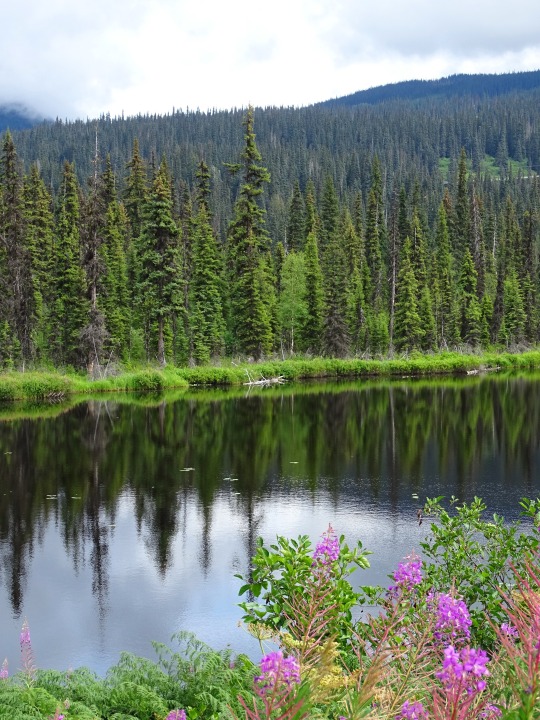

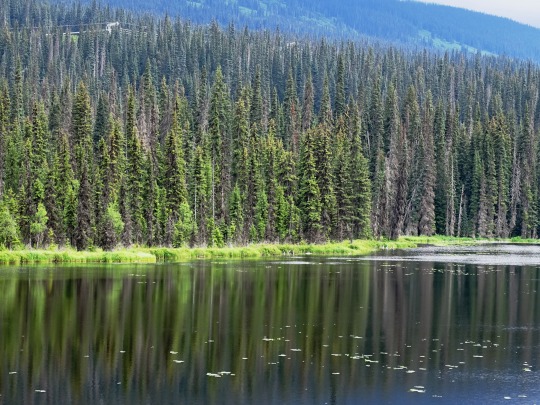
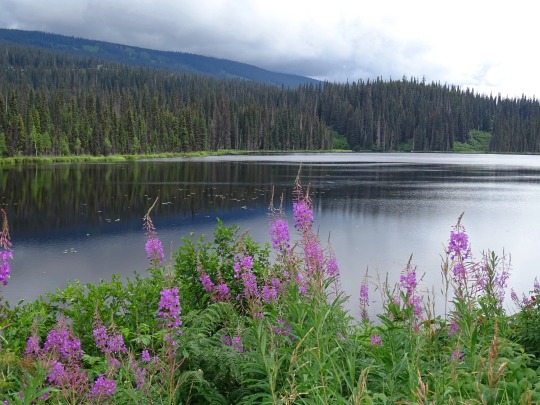
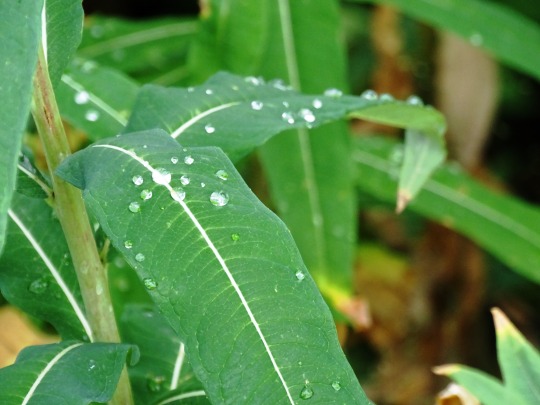


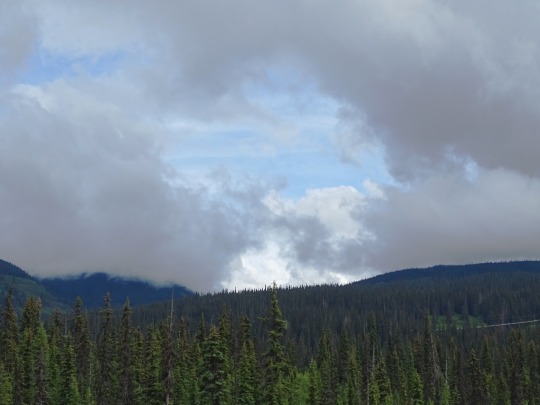

Mehan Lake, BC (No. 2)
Chamaenerion angustifolium is a perennialherbaceousflowering plant in the willowherb family Onagraceae. It is known in North America as fireweed, in some parts of Canada as great willowherb,[1] in Britain and Ireland as rosebay willowherb. In the United Kingdom it is also known as bombweed,a result of its rapid appearance on city bomb sites during the Blitz of World War II; the plant is also traditionally known as Saint Anthony's laurel. It is also known by the synonymsChamerion angustifolium and Epilobium angustifolium. It is native throughout the temperate Northern Hemisphere, including large parts of the boreal forests.
The generic name Chamaenerion means 'dwarf-oleander' and the Latin specific epithet angustifolium translates as 'narrow-leaved'. It shares this epithet with many other species of plants, including Vaccinium angustifolium. The common British name "rosebay", from the passing resemblance of the flowers to (wild) roses and the leaves to those of bay, goes back in print to Gerard's Herball of 1597. The common American name "fireweed" derives from the species' abundance as a colonizer on burnt sites after forest fires and other disturbances.
Source: Wikipedia
#Mehan Lake#Skeena Region#Skeena Country#Stewart Highway#Glacier Highway#original photography#travel#vacation#tourist attraction#landmark#landscape#countryside#nature#Canada#summer 2023#fir#the North#cityscape#forest#woods#flora#food#British Columbia#wildflower#Stikine Highway#Highway 37 Stewart-Cassiar Scenic Route#water drops#reflection
1 note
·
View note
Text

15 notes
·
View notes
Text
Hi... so. I want to talk about the last CG that’s in Saeran’s After Ending if that’s okay with all of you? Don’t click this unless you’re okay with seeing this spoiler or if you’ve already learned what happens in the Good Ending. Either way, it’s your choice what you click. I warned you. It’s the only thing that I’ve been able to think about all day.
I narrowed down what I thought the flowers were and honestly, I don’t know if I’m right but I did craft together a list of what I personally see the flower as because not all of them are obvious. Let’s start with the easy one, and that would be our MC.
They are wearing a crown of pink roses, and in this case, I think they are in the way of saying “Perfect Happiness,” as this is the ending and it’s the final shot that we share. This was the literal easiest one to discern because it’s a cute little crown that I know Saeran made for the MC.
He is saying that you are perfect and this is bliss.
The bouquet that Saeran is holding in this, as far as I can tell, is made up of Red Roses and Hyacinth.
Red Roses are the ultimate sign of love and passion to the one that you love. He is saying he loves us more than anything else in this world ever could. White Hyacinth are a sign of loveliness and that you’re thinking and praying for someone. Together, that’s something that says that you are so very lovely and our love is perfection.
The bouquet that Saeyoung is holding in this phot, as far as I can tell, is made up of Hydrangea and Dwarf Fireweed.
Hydrangeas are given as thank you to someone that understood you. It’s a gift of saying, thank you for seeing me and helping me and in this case, it’s him and Saeran. This is his thanks. I was a bit torn on this, but I went with Fireweed for what it symbolizes. Release, rebirth, or the growth of something entirely new.
In this CG and what I hope to be confirmed in my Passport Package once it gets to me from Korea, is that after the events of the Good Ending proper, both of the Choi Boys and MC decide to travel. It’s time to see the world that was not gifted to them at the start. We’re moving forward with love, with growth, with change, and with the thought of making our promise of happiness bloom as the Lily of the Valley surround us.
What I really wanted to say here is that SAERAN CHOI GOT THE FUCKING PICNIC THAT I WANTED FOR HIM AND THAT I WOULDN’T SHUT UP ABOUT SO YOU KNOW WHAT, I’M HAPPY. I STARTED CRYING AGAIN.
Okay, okay, I will check my chill for you here at the door. Saeran literally says cheers at the end, as if there’s a toast. That means picnic time. Do not tell me I’m wrong. I’m happy that we’re together, and I’m happy that we’re all together now and nothing will ever separate us again. All of these flowers... I’m just... I’m still really emotional about all of this right now.
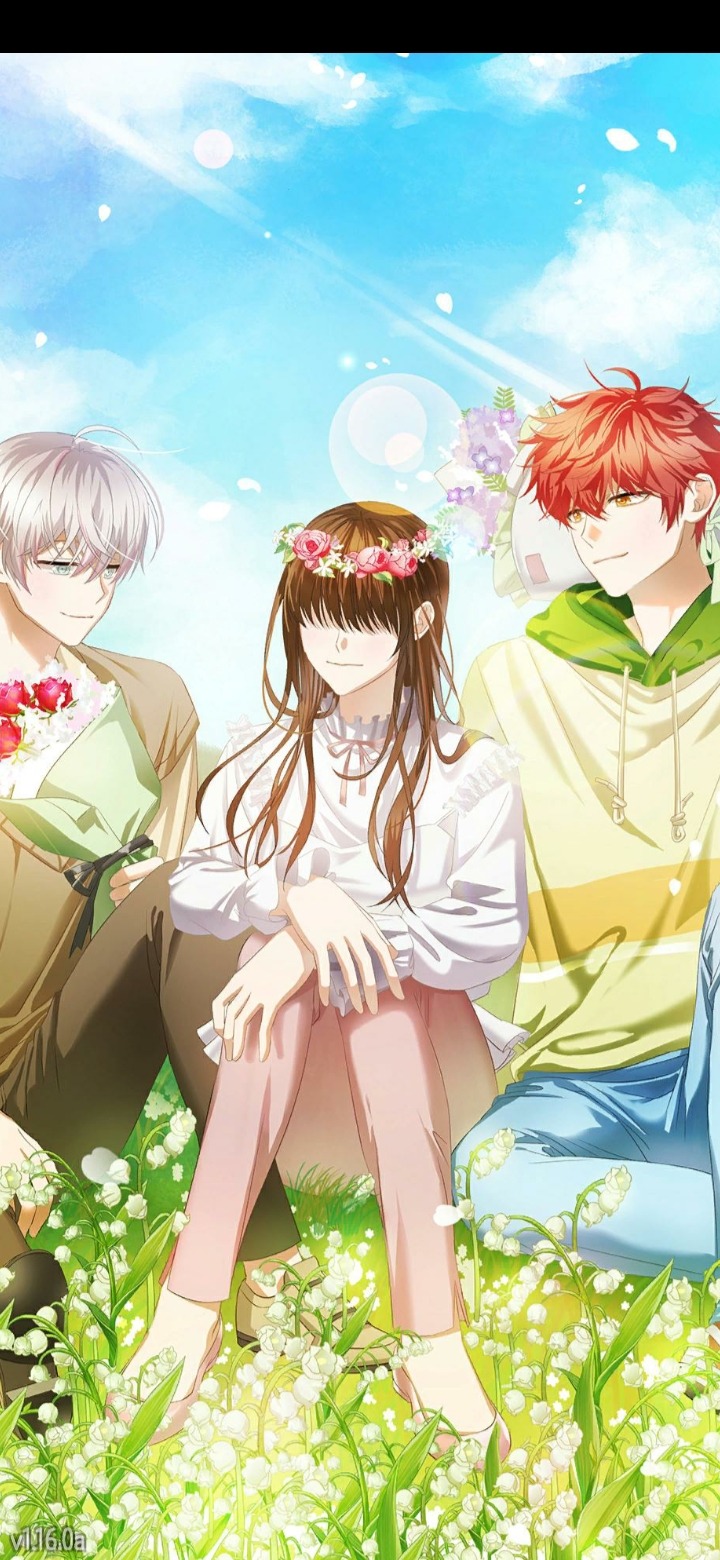
#character analysis#SaeranAfterEnding#saeran after ending#saeran ae#saeran choi#choi saeran#saeyoung choi#choi saeyoung#luciel choi#choi luciel#ray choi#choi ray#mm#mysme#mysticmessenger#mystic messenger#mod kait#saeran mysme#saeran mystic messenger#saeran mm#seven mysme#seven mm#seven mystic messenger#mystic messenger seven#mysme seven#mysme saeran#mystic messenger saeran#mm saeran#mm seven#707
80 notes
·
View notes
Photo

Two of Cups. Art by Mariza Aparicio-Tovar, from the Gentle Tarot.
“Two of Cups,” giving and receiving. Connection and the sacred space created by two.
The drops of water falling towards the forehead are representative of intellectual and spiritual awakening.
The cups and water are symbols for the gentle pouring and exchange of emotions.
This bonding is depicted like a mirror to represent calm, healthy reciprocity, and also a healthy relationship with self. 🤟🏽
Sharing another Alaskan wildflower, here we have the Dwarf Fireweed.
The flower is there representing love and growth.💜
9 notes
·
View notes
Photo
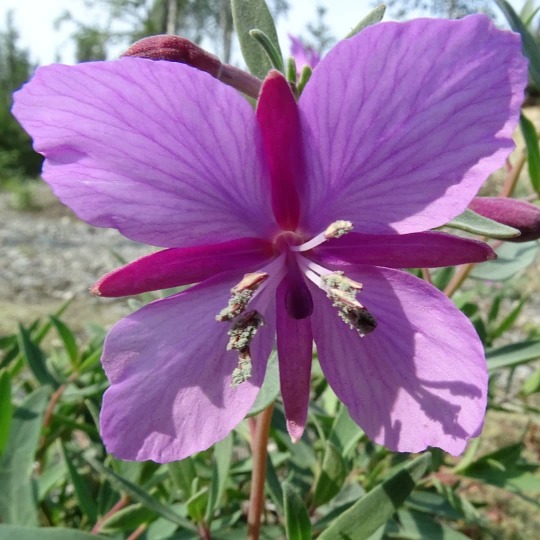
𝘊𝘩𝘢𝘮𝘢𝘦𝘯𝘦𝘳𝘪𝘰𝘯 𝘭𝘢𝘵𝘪𝘧𝘰𝘭𝘪𝘶𝘮 More dwarf fireweed. (at Soldotna, Alaska) https://www.instagram.com/p/CSqoYsxrNlP/?utm_medium=tumblr
0 notes
Text
Smoothie Ideas
Unasked for, but liked by some! If I had access to all of these (and under responsible circumstances) and a good amount of space to work with as well as room in a freezer, and a good blender/food processor, this is what I would do. All plant parts in equal amounts. Plus plain yogurt and silky tofu for texture. And honey, tulip tree nectar, and syrups of sugar maple, boxelder maple, red maple, black maple, silver maple, mountain maple, swamp maple, yellow birch, sweet birch, water birch, paper birch, gray birch, bog birch, butternut, black walnut, American sycamore, basswood, silver linden, green alder, mountain alder, American elm, slippery elm, and rock elm for added sweetness.
Canada Day smoothie
honey: summer
American chestnut
American ginseng
aster petals:
fringed blue
heart-leaved
New England
panicled
smooth
avens roots:
purple
prairie smok
white
yellow
bayberry fruits and leaves:
northern
sweet gale
beebalm flowers:
horsemint
scarlet
wild bergamot
blackberries and raspberries:
Allegheny blackberry
American red raspberry
arctic raspberry
black raspberry
blue raspberry
Canadian blackberry
cloudberry
common dewberry
dewberry
glandstem blackberry
leafy-bracted blackberry
loganberry
Pennsylvania blackberry
purple-flowering raspberry
salmonberry
setose blackberry
sphagnum dewberry
swamp dewberry
thimbleberry
trailing raspberry
bluebells:
tall
Virginia
blueberries and cranberries:
bog bilberry
common blueberry
deerberry
highbush blueberry
hillside blueberry
large cranberry
lingonberry
lowbush blueberry
small cranberry
Canada buffaloberry
Canada ginger root
Canada yew berry
cattail hearts:
broadleaf
narrowleaf
cherries and plums:
American plum
Canada plum
black cherry
chokecherry
pin cherry
sand cherry
chokeberries:
black
red
columbine flowers:
Canada
smallflower
common hop
common yarrow flower and leaf
cow parsnip stalk
cranesbill flowers:
herb robert
wild geranium
crowberry
cucumber tree flower
currants and gooseberries:
American blackcurrant
American gooseberry
Canadian gooseberry
golden currant
northern blackcurrant
northern redcurrant
prickly gooseberry
skunk currant
dogwood fruits:
blue-fruited
bunchberry
flowering
gray
red osier
eastern hemlock tip
eastern white cedar tip
elderberries:
American red
common
false Solomon’s seal berries:
Canada mayflower
false Solomon’s seal
starry false Solomon’s seal
fireweed
fleshy dandelion flower
forget-me-not flowers:
largeseed
smallflower
spring
goldenrod flowers:
Canada
gray
prairie
sticky
goldenseal
greenbrier berries:
blue ridge carrionflower
bristly
common
Illinois
smooth carrionflower
upright carrionflower
groundcherries:
clammy
common
Virginia
hackberries:
dwarf hackberry
hackberry
haws:
cockspur
fireberry
dotted
downy
hazelnuts:
American
beaked
hickory nuts:
bitternut
pignut
shagbark
shellbark
honey locust pod pulp
honeysuckle fruits and flowers:
black twinberry
Canadian fly
haskap
mountain fly
hyssops:
anise
purple giant
Jack-in-the-pulpit berry
juniper berries:
common
creeping
eastern
Kentucky coffee tree pod pulp
kinnikinnick berry
lily flowers:
Canada
Michigan
wood
linden flowers:
basswood
silver
maple blossoms and seeds:
black
boxelder
mountain
red
silver
sugar
swamp
mayapple
milkweed pods and flowers:
butterflyweed
common
fourleaf
green comet
oval leaf
poke
prairie
purple
redring
swamp
tall green
whorled
mints:
Canada
peppermint
wild
mountain woodsorrel flower, leaf, and fruit
Oregon grapes:
creeping
Oregon grape
partridgeberry
pawpaw fruit
pine tips and young cones:
eastern white
jack
pitch
ponderosa
red
pokeweed berry juice
prickly cucumber juice
prickly pears:
fragile
devil’s tongue
ramps flower
red mulberry
redbud flower
riverbank grape
robin runaway flower
rose mallow flowers:
Halberd-leaf
swamp
rose petals and hips:
climbing wild
pasture
prairie
prickly wild
shining
smooth
swamp
Virginia
woods’
roughfruit fairybells berry
sarsaparillas:
American spikenard
bristly
wild
sassafras
serviceberries:
Allegheny
Bartram juneberry
Canadian
downy
inland
low shadbush
pigeonberry
roundleaf
saskatoon
silverberry
snowberries:
coralberry
snowberry
western
spicebush
spruce tips and young cones:
black
red
white
stinging nettle top
strawberries:
Virginia
woodland
sumac berries:
fragrant
shining
smooth
staghorn
sunflower petals, tubers, and seeds:
cheerful
giant
narrowleaf
Nuttall’s
pale-leaf
stiff
sunchoke
woodland
sweet crabapple fruit and blossom
sweetfern leaves
sweetgrass
tamarack tip
twisted stalk berries:
rose twisted stalk
watermelonberry
unicorn root
viburnum berries:
arrowwood
highbush cranberry
mapleleaf
nannyberry
snowball tree
squashberry
witch’s hobble-bush
witherod
violets:
arrowleaf
bird’s foot
Canada
crow-foot
downy yellow
early blue
Labrador
long-spurred
marsh
marsh blue
New England blue
northern bog
northern woodland
small white
sweet white
wood
Virginia creeper berry pulp
walnuts:
black
butternut
wild savoury and wild basil leaves
wild yam
wintergreens:
American
creeping snowberry
witch-hazel
5 notes
·
View notes
Text
17 - 23 August 2020
The feasting continued Monday in Montanay when other friends came over for a long, leisurely dinner. There has been a constant stream of visitors here and always lots of delicious food.
Tuesday, I made my way to Geneva. Day one out of quarantine-listed France.


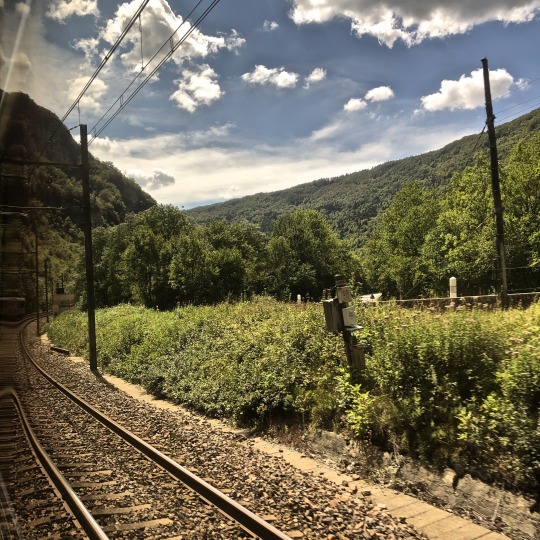

Sergio and I spent the afternoon basking in the sun at Bains des Pâquis on Lac Léman across from the Jet d’Eau.
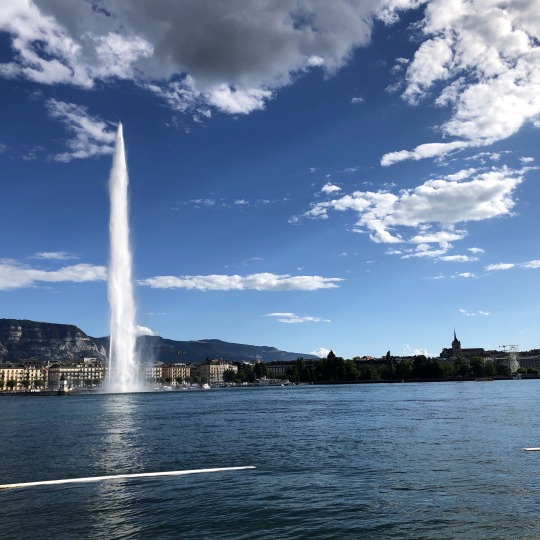
It was nice to visit Geneva in the summer for the first time. Life revolves around the lake and the Rhône. We enjoyed an evening boat trip across the lake then a nice walk along the lake before we stopped for an aperitif. It just so happened several of Sergio’s friends were there too, which was nice.
I was on the 08.15 train from Geneva to Cologne Friday morning. I had to change twice. I enjoyed views of Lake Geneva, Lake Neuchâtel and the rolling countryside.

There were only a handful of people in my carriage on the seven hour journey. In Germany, there was an influx of camouflage-clad youth. It must have been a day to return to duty.
Friday night in Köln we attended a wine paring dinner. The food was delicious and I generally preferred the Riesling wines. With each course we were given a Riesling and an Austrian wine to compare. We started with a bubbly rosé from Austria and finished with a very nice, slightly sweet, Riesling.
Saturday was a lazy day. Sunday, Jody from Antwerpen, who works in Köln, joined us for afternoon tea.
The CoVid cases in Germany are going up; I’m crossing my fingers it isn’t added to the quarantine list before I return to London on 2 September.
Plant of the week
Onagraceae Oenothera macrocarpa Nutt.

common name(s) - bigfruit evening primrose, Ozark sundrop, Missouri evening primrose, dwarf evening primrose
synonym(s) - Megapterium macrocarpum (Nutt.) R.R.Gates; Megapterium missouriense (Sims) Spach; Megapterium nuttallianum Spach; Oenothera macrocarpa var. missouriensis (Sims) Carrière; Oenothera missouriensis Sims; Oenothera missouriensis var. latifolia A.Gray
infraspecific taxa - Oenothera macrocarpa subsp. fremontii (S.Watson) W.L.Wagner; Oenothera macrocarpa subsp. incana (A.Gray) W.L.Wagner; Oenothera macrocarpa subsp. mexicana W.L.Wagner; Oenothera macrocarpa subsp. oklahomensis (Norton) W.L.Wagner
conservation rating - none
native to - Central & E. U.S.A. to Mexico
location - friend’s garden in Wuppertal, Germany
leaves - dark green and lanceolate, and bunched along the trailing stem
flowers - large, wide flowers are cup shaped, canary yellow and have a mild fragrance; produced in great numbers from early to mid summer; seed pods are four-winged
habit - tap-rooted, herbaceous, sprawling perennial to 300mm tall
habitat - calcareous prairies and limestone outcrops
pests - slugs
disease - leaf spots, mildews, root rot
hardiness - to -15ºC (H5)
soil - well-drained, dry, poor
sun - full sun
propagation - seed, will self-seed
pruning - none
nomenclature - Onagraceae - Ancient Greek name onagra, once used for fireweed; Oenothera - unclear but may have come from the Greek words oinos and theras meaning wine-seeker in probable reference to an ancient use of the roots of genus plants in scenting wine; macrocarpa - large-fruited
NB - AGM; seed pods are often used in flower arrangements; culinary uses: leaves and flowers can be added to salad; roots can be used in their second year as a vegetable (like parsnip) in soups and stews; oil from their seeds is used to regulate hormones and can help PMS; can be used to treat inflammation conditions like arthritis; used to treat eczema and other dry skin complaints; can be used as a sedative or to treat diarrhoea; roots can be used to treat stubborn coughs; can lower cholesterol and blood pressure
References, bibliography:
Gledhill, David, (2008) “The Names of Plants”, fourth edition; Cambridge University Press; ISBN: 978-0-52168-553-5
IUCN [online] http://www.iucnredlist.org/search [27 Aug 20]
Missouri Botanical Garden [online] http://www.missouribotanicalgarden.org/PlantFinder/PlantFinderDetails.aspx?kempercode=e390 [27 Aug 20]
Plant List, The [online] http://www.theplantlist.org/tpl1.1/record/tro-23200579 [27 Aug 20]
Plants of the World [online] http://plantsoftheworldonline.org/taxon/urn:lsid:ipni.org:names:173157-2 [27 Aug 20]
Royal Horticultural Society [online] https://www.rhs.org.uk/plants/70730/Oenothera-macrocarpa/Details [27 Aug 20]
Victoriana Nursery Gardens [online] https://www.victoriananursery.co.uk/Evening-Primrose/ [27 Aug 20]
Wikipedia [online] https://en.wikipedia.org/wiki/Oenothera_macrocarpa [27 Aug 20]
SARS-CoVid-2 update (map showing active cases only)

0 notes
Text
Harding Icefield Trail
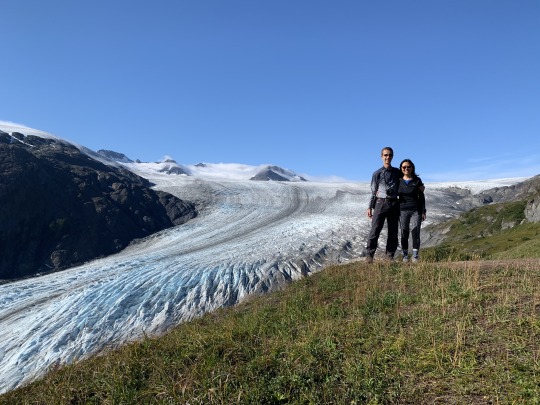
Date of hike: August 20, 2020
Country: USA
Region: Alaska
Trailhead: Exit Glacier Nature Center, near Seward, AK
Hike Destination: Harding Icefield Overlook
Distance: 9 miles (13.5 km), out and back trail
Overall elevation gain: 3,400 ft. (ca. 1,100 m.)
Difficulty: Intermediate
Seward, which is situated on the Kenai Peninsula of Alaska, gets 40% more days without sunshine per year (232) than does Boston (where we currently reside). Thus, while sunny days cannot be taken for granted anywhere in the US, except maybe in Las Vegas, they can even be less taken for granted on the Kenai Peninsula (or anywhere else in Alaska, for that matter). That’s why we were truly grateful and highly excited when we woke up to a bright sunny day for what was planned to be the highlight, hiking-wise, of our 12-day tour of Alaska.
We stayed at the Seward Windsong Lodge, located next to Resurrection River, and from there it is just a 15 minutes drive to reach the Exit Glacier Nature Center, inside Kenai Fjords National Park. To approach the visitor center is to get an object lesson in the intricacies of climate change. Roadside signs with years on them show how far the glacier used to reach in former times.

Based on analysis of vegetation age and various geographic markers, scientists determined that the glacier reached its furthest expansion at the end of the “Mini Ice Age,” around 1815. Since then, Exit Glacier has retreated a staggering 2 kilometers up the valley, living up to its name as a glacier on the way out. When we passed the first placard with the oldest date on it, I took it for a joke because we were surrounded by lush forest; but 200 years ago, we’d have been faced with a mass of shimmering, compressed ice at this very spot. Since the onset of the Industrial Revolution, the Glacier has retreated at a rate of 13 meters per year on average. This is a good indication that glacial retreat is not only a function of man-made greenhouse gas emission (which were minimal in 1815), but that human activity compounds large-scale climactic factors and that both work together to fuel the melting of glaciers. As far as I know, the question of what proportion of climate change is due to natural cycles and what is due to human activity remains a point of contention.
The trail up to the Harding Icefield is very popular, and for good reasons: Starting at a short distance from Seward, it is a hike of moderate difficulty and reasonable length (9 miles), offering huge rewards of grand sub-arctic mountainscapes. It is a good idea to arrive at the trailhead early, especially on a splendid day like we experienced it, although due to Covid-19, far fewer tourists than usual were in Alaska at the time. No cruise ships were docking in Seward all season, and the complicated travel restrictions and testing requirements have generally raised the bar on travelers arriving from far away places. Somebody told us that because of Covid-19, 1 million fewer people were in Alaska right now than a year ago. To put this figure in perspective, the entire resident population of the state is only 740,000. The tourism industry and all depending on it are clearly smarting from this situation, although Alaskans are picking up some of the slack by coming out in greater numbers than usual to see their own land. But it is one of the ironies of an otherwise baneful global pandemic that pristine natural attractions are rendered more pristine by the absence of hordes of tourists.
We started out on the trail at 8:45 am, full of vigor and anticipation. We must have been among the very early birds since we didn't encounter anybody until close to noon, when some hikers who had overnighted somewhere in the backcountry were heading back our way. The trail is very well maintained and ascends at a pleasant rate, although some tall steps are encountered in the steepest sections. The first hour was spent mainly in alder, cottonwood, and spruce forest, which then gave way to shorter, stunted vegetation higher up, allowing a first glimpses of Exit Glacier, a gigantic river of ice lumbering down the mountainside, literally frozen in time.
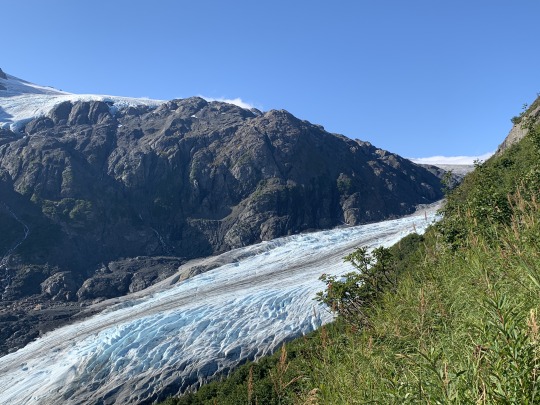
Exit Glacier is one of 38 glaciers spilling out from the Harding Icefield which entirely covers central Kenai Peninsula at a surface area of over 700 square miles (or roughly the size of the island of Maui).
One of the great advantages of heading out early on this hike, besides enjoying an uncrowded trail, is that the light is much more favorable to bringing out the sculpted features of the landscape, exposing the blue ice shimmering from deep clefts in the glacier, while photogenic tendrils of vapor slide over the mountaintops in the background enhancing the dramatic effect. Once the sun moves further south and then swings west in the later afternoon, the light turns flat and blinding, as the viewer looks more or less directly into the glare over the glacier, and this takes a toll on the color spectrum and dimensional nuances of the scenery.
After one hour of steady climbing, we reached the first overlook where we got a close look at the plunging Exit Glacier. We had a brief sit-down here and drank some water. Then, we tackled the steepest portion of the trail, as it switch-backs up and around a bluff, while the vegetation goes from brush to tundra. Looking back down to that first lookout, we realized that it had meanwhile been populated by fellow hikers who had come in our wake.
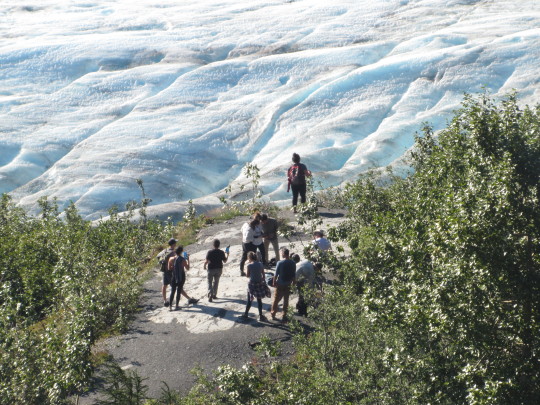
After taking this photo with a tele lens, we deftly continued upward, calling out “oyeee! oyeee!” as a warning to potential bears. Telling the beasts that you are in their neighborhood is the best defense against unpleasant encounters with them, as they are usually shy and eager to avoid contact with humans. But when they are surprised or crowded, they can quickly and viciously turn on people. Like most hikers in Alaska, we also carried bear spray, but on a test of this device--discharging the can before we flew home--we found it to be of dubious efficacy, as the cloud of pepper gas was easily dissipated, with a reach of only about 5 meters. It seemed a puny way of defending oneself against an outraged 600 pound animal. Carrying the bear spray does more to calm the hiker’s nerves than it offers real protection in case of an emergency... hence the noise-making as the first and most important line of defense.
As it turned out, on this hike we did not encounter any bear (though another party following after us did, at fairly close range). We also did not spot other large wildlife and had to make do with a couple of marmots and grasshoppers. We did not mind, of course, since the scenery offered all the visual gratification that we could hope for. I'll never forget the moment when we crested a bluff and stepped out unto the ridge that looks down upon the majestic glacier, as it swings around in a broad curve, exposing a dramatic backdrop of icy expanse and serrated mountain tops.

It was as good an instance of the sublime feeling of awe in nature as can be had. The vastness of the scene was overpowering, and we were glad to sample it in solitude. Because the glacier is so enormously thick--measuring up to one mile in depth--the peaks are almost entirely submerged, which creates a unique landscape type, only available in the far north (as well as the Antarctic, of course). It is hard to imagine that all of this splendor could one day be melted away, but in the far future, we might be looking into a valley instead of a plain brimming with endless amounts of ice and snow.
The next portion of the trail, up to the ultimate turn-around point, goes from tundra to rocky terrain to black scree that resembles the surface of an uninhabited planet. This was my favorite stretch of the trail, with the huge expanse of the Harding Icefield gradually coming more clearly into view, as the trail climbs higher and higher above the glacier, while the vegetation becomes more and more sparse yet luminous. The dwarf fireweed were lovely to behold, and in some places they formed bright patches that attracted the eye in this austere landscape.
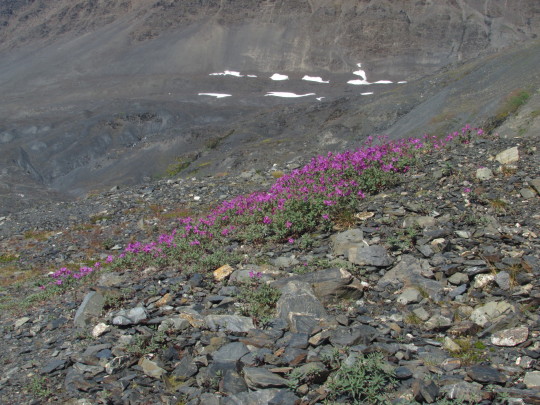
Even the mosses were extraordinary here, eking out a living in forbidding conditions, brightly lining the border of small ponds along the way.
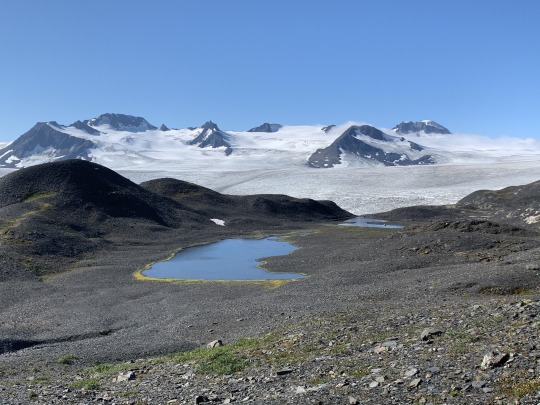
The trail passes a small emergency shelter shortly before it reaches the end. When we peeked inside the shelter, there was nothing but four windowless walls and a bare floor. Not a stick of furniture or a stove to be seen. “Spartan” is probably an overstatement for this establishment. But for mountaineers in distress, the shelter can make the difference between life and death.

It is hard to imagine the violent storms that tear through this region in the winter, or the bone-chilling cold and relentless darkness that will hold sway here in a few months' time. But right now, we were basking in gorgeous summer sunshine, with temperatures in the mid-60s, and with excellent visibility—better conditions cannot be imagined for a hike in this mountain wilderness. The contrast with what it could be like here in other circumstances is almost unreal.
Soon after the emergency shelter, the path, which follows an old moraine, emerges on a small bluff, all rock and stone with no vegetation.
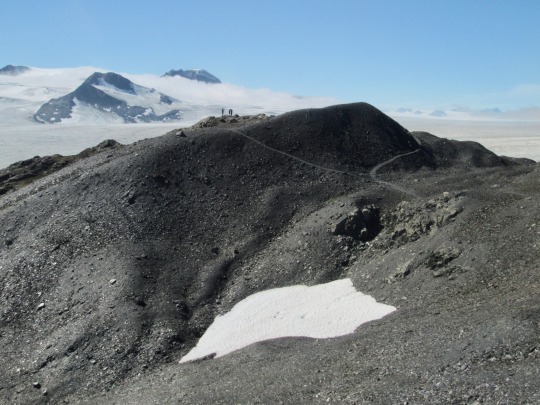
Here, we sought a nice secluded spot to the side of the trail and sat down for a leisurely lunch picnic, pondering the vastness of the vista and feeling comparatively small. In the bluish distance of the Harding Icefield, a row of grey conical mountain tops pierced the mile-thick ice pack like newspaper hats bobbing on a milky ocean.

On the way down, we met increasing numbers of hikers going up, including a gaggle of teenagers equipped only with water bottles who were asking how far it was to the end of the trail. It was 3 pm, and they did not give the impression of having the grit to sprint all the way up to the end of the trail, although coming this far without going to the final overlook seems a bit like a letdown.
This really is a popular hike, and I can only imagine how busy it would be without Covid. At 9 miles round-trip (13.5 km), with 3,400 feet (roughly 1,100 meters) elevation gain, it is a substantial hike, but nowhere exposed, technical, or uninteresting. There is no better way, in my mind, to spend a sunny day in Alaska than going up to the viewpoint at the end of the Harding Icefield track.
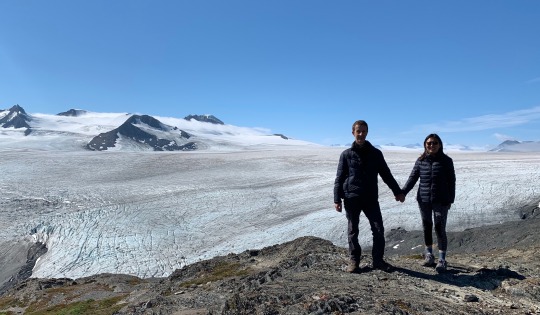
We returned to the visitor center at around 4:30 pm, quite tired but not worn out and certainly in very high spirits. There was not much room for our spirits to go higher, even after popping a couple cans of cold Alaskan beer in celebration of a perfect day.
0 notes
Text
Greenland OC
(Kat)
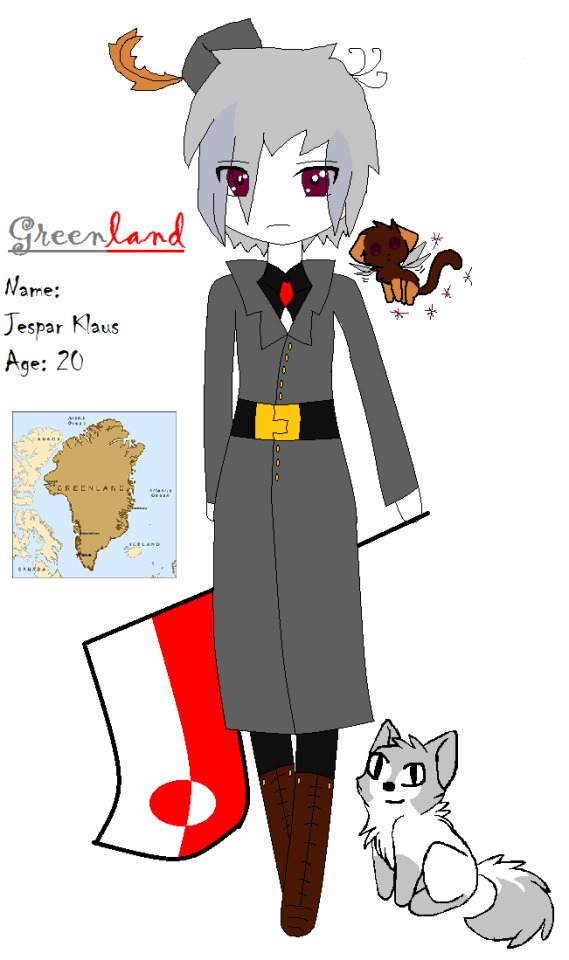
Let me start on his appearance. No one in Greenland is this pale, No one in Greenland has white hair and red eyes. People in Greenland look something like this.

Dark hair and dark eyes.

Greenland
Name: Jespar klaus (Jespar-Danish variant form of Jasper) (Klaus-Short form of Claudius)
Problem. He's not Denmark, he's Greenland, and he needs a Greenlandic name. Moreover, Klaus isn't a name that fits into the language spoken there.
Human age:
20-21`
That's... fine, I guess.
Birthday:
14 October
On the 14th of October in Greenland, absolutely nothing happened.
Height:
5"3 (160 centimeters)
Weight:
100lb (45.36kg)
That's healthy. Good.
Personality:
can be quite serious,has a good sense of humor,is fun to be around(sometimes),stuck up at times,is never rude to people(unless he has to be),not out going,quiet,plain.

Okay, this is just bland. The only thing there that resembles a flaw is 'plain' and that isn't even an actual flaw.
Likes:
snow,being alone,being quiet and non-social,keeping things neat and in line,peace,animals,magic

Dislikes:
loud/rude people,messy things,sun,fights or anything to do with fights,war
Why does he hate the sun??????
——————————————————————————————————-
Relations:
Denmark: Half-brother
Norway: Half-Brother
Iceland: Half-Brother
Yes, but
H I S T O R Y
Please, this entire OC hasn't had a word of History, and that is what Hetalia primarily is. RESEARCH IS IMPORTANT.
Pet(s):
Greenland Dog (Grønlandshunden)
Name of dog: Kai (short form of the Frisian name Kaimbe = ‘warrior’)
Gender:
male
The dog itself is fine, but the name is not. The Frisian languages are a closely related group of Germanic languages spoken by about 500,000 people. They live on the southern fringes of the North Sea in the Netherlands and Germany. This has nothing to do with Greenland. Give the dog an Inuit name for God's sake.
Age:
293 (when greenland became part of denmark?) (plz correct me if im wrong)
Contact was first established from Norway in 1261 and then re-established in 1721. As of this year, first contact would have been established 756 years ago.

Capital:
Nuuk
National flower:
Dwarf Fireweed
Language:
Greenlandic
And every Inuit language spoken there, as well as Danish.
Government:
Constitutional monarchy, Parliamentary system
Currency:
Danish krone
This is correct.
Natural resources:
coal, iron ore, lead, zinc, molybdenum, diamonds, gold, platinum, niobium, tantalite, uranium, fish, seals, whales, hydropower, possible oil and gas
...I don't see why this is necessary.
Overall, this OC wasn't horrible. Whoever made it didn't put the amount of effort into it that would make it great. But there were some gaping holes where the history should of been. Please, this is why it is important to do your research.
I'm out.

~Kat
#ohnohetaliasues#greenland oc#aph greenland oc#aph greenland#aph hetalia#aph hetalia oc#Axis Powers Hetalia#Axis powers ヘタリア#mary sue#gary stu#do your research hetalia fans
15 notes
·
View notes
Photo
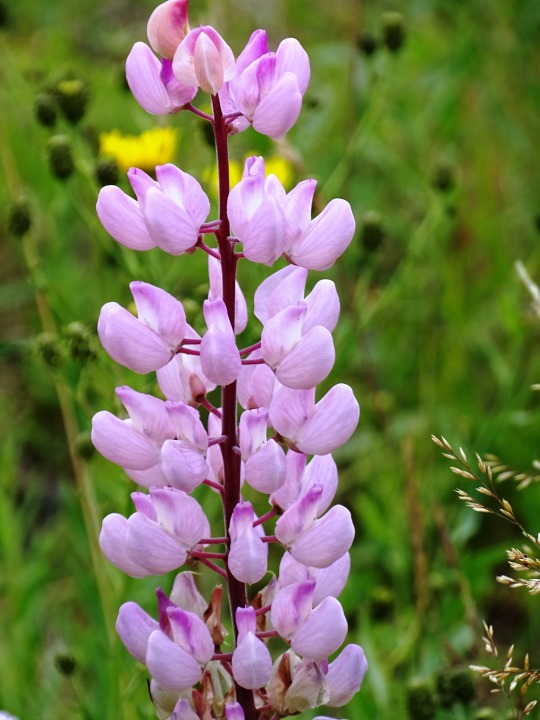



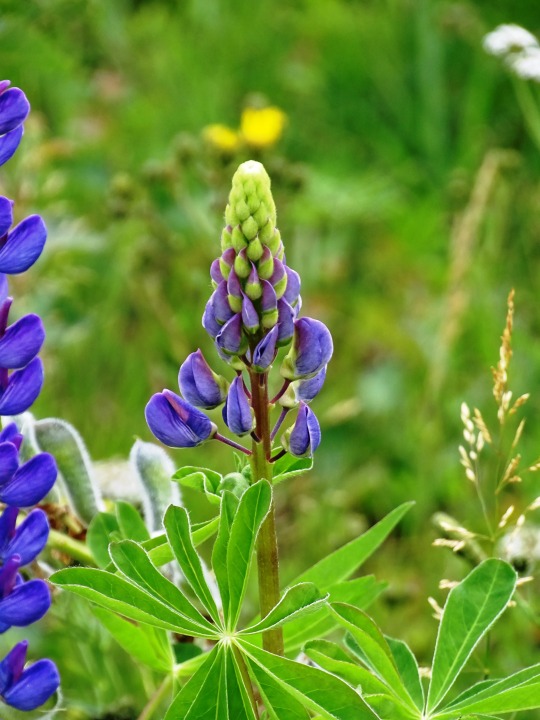




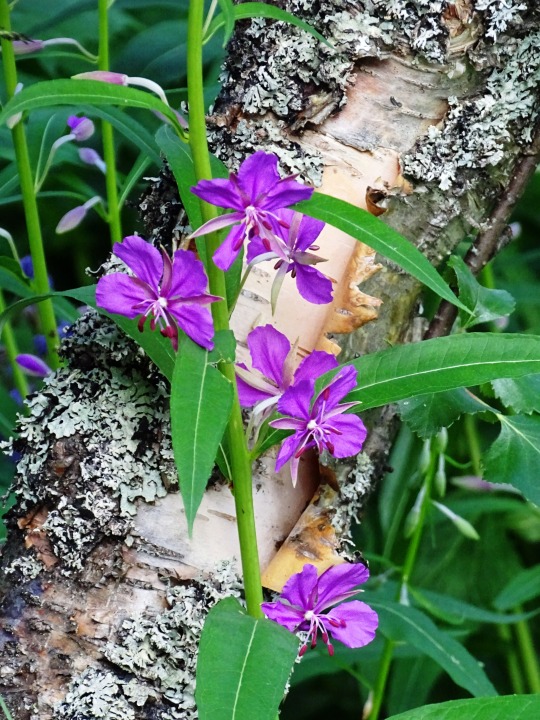
Wildflowers in Sweden
Skåne and a narrow strip along the west coast belong to the nemoral zone where beech (Fagus sylvatica) is the dominant tree species. Forest herbs in this zone commonly vegetate and flower in spring, as the crown of beech is very dense, and little light reaches the ground once the leaves appear. Examples are Anemone spp. and Corydalis spp. Oak (Quercus robur and Quercus petraea) forest occurs on poor soils. Forest of alder (Alnus glutinosa), ash (Fraxinus excelsior) and elm (Ulmus glabra) grow in nutrient-rich, often wet soil, but most of these areas have long since been drained and converted to arable fields.
Most of Sweden below the mountains is covered by conifer forest and forms part of the circumboreal zone. South of river Dalälven, there are scattered deciduous trees like oak (Quercus robur), and this zone is referred to as boreo-nemoral. North of Dalälven, in the proper boreal (taiga) zone, deciduous trees are rarer, but birches (Betula pubescens and Betula pendula) and aspen (Populus tremula) may be abundant in early successional stages, such as after fire or in recently clear-cut areas. There are a total of four native conifers in Sweden, and of these only Norway spruce (Picea abies) and Scots pine (Pinus sylvestris) form forests, in pure or mixed stands. Spruce grows wetter and pine drier, but in bogs there are often numerous dwarfed pines. Undergrowth in spruce forest is commonly almost pure stands of bilberry (Vaccinium myrtillus). In wetter types ferns (e. g. Athyrium filix-femina and Dryopteris spp.) are abundant and in richer parts herbs (e. g., Paris quadrifolia, Actaea spicata) and broad-leaved grasses (e. g. Milium effusum). In pine forest, lingonberries (Vaccinium vitis-idaea), heather (Calluna vulgaris) and/or Cladonia lichens are most common. Fires occur at irregular intervals, and usually kill all spruce and most pines. Fireweed (Epilobium angustifolium), raspberry (Rubus idaeus) and Geranium bohemicum are among the first plants to germinate in the ashes.
Source: Wikipedia
#flora#lupinus#wildflower#Northern Wolf's-bane#grass#nature#Sweden#Sverige#Scandinavia#original photography#summer 2020#travel#vacation#Northern Europe#tourism#thistle#goldenrods#birch#fireweed#countryside#close up#tree#woods#forest#Swedish Lapland
2 notes
·
View notes